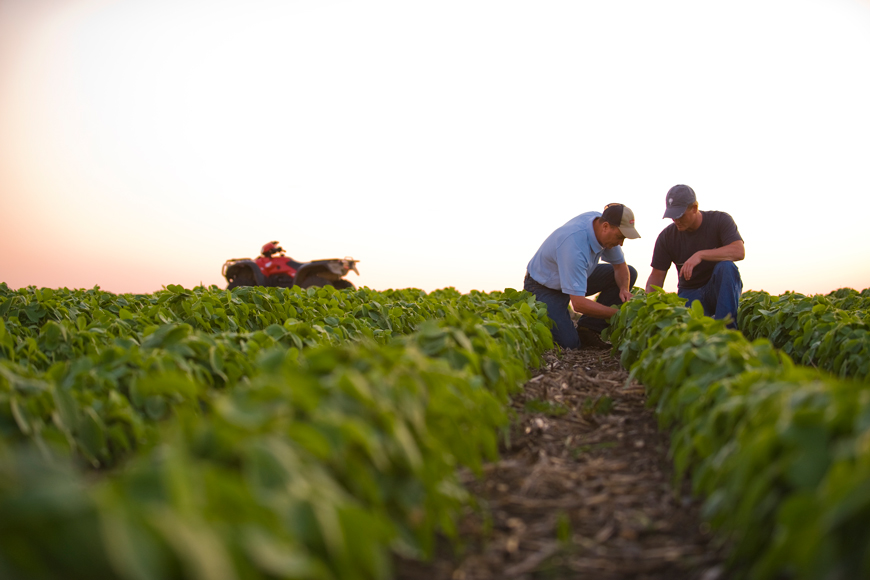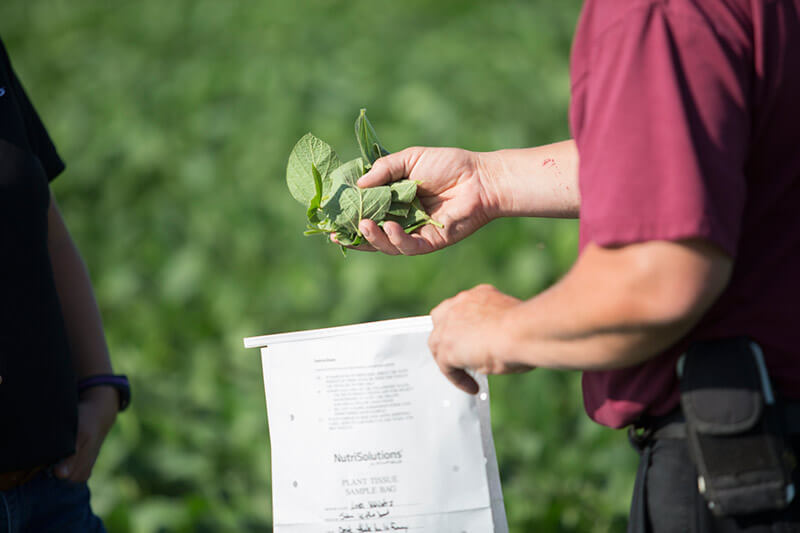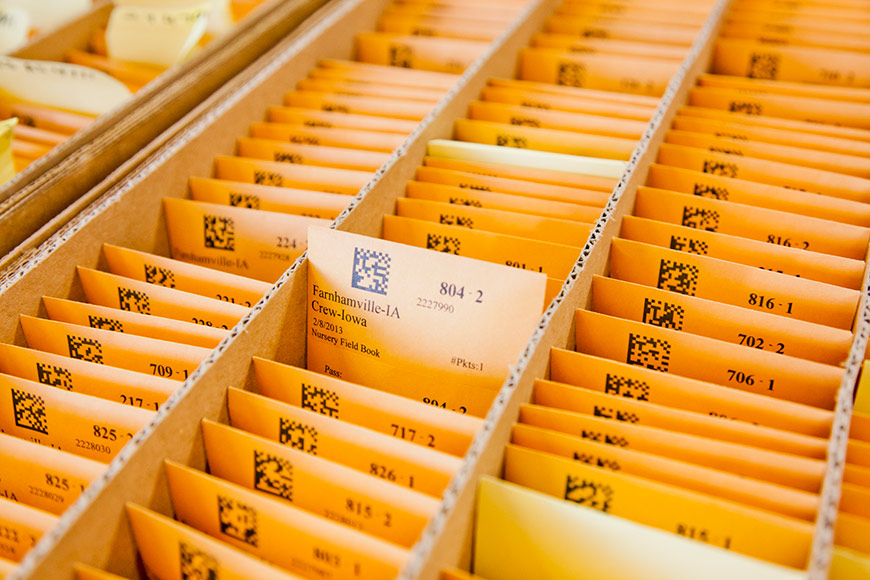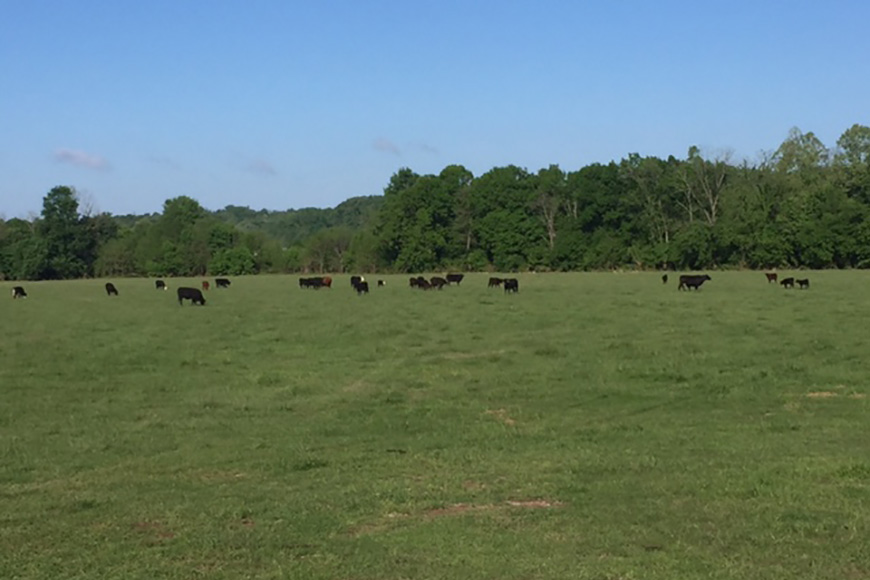3 Tips for Managing SDS in Soybeans

Dry conditions across much of the Corn Belt kept sudden death syndrome (SDS) in soybeans at moderate levels during the 2023 growing season. When the disease did show up, it generally came in late, which limited yield losses. This year, however, has been a different story. With overwhelming moisture in many key growing regions, SDS is expected to be more prevalent. Consider implementing these management practices to help protect your soybeans from SDS this season.
SDS is a soilborne disease that infects soybean roots shortly after germination, but symptoms don’t appear until mid or late-summer and are often accompanied by cooler temperatures and significant rainfall. The disease’s two-phase infection pattern initially results in root rot. Then, during the late vegetative or early reproductive stages, the root-infecting pathogen produces a toxin that induces the foliar necrosis typical of SDS.
Foliar SDS symptoms are similar to those of nutrient deficiencies and other diseases, including brown stem rot and stem canker, making it difficult to diagnose correctly. To accurately identify SDS in your crop, dig plants and split the stems open. If the plant is infected with SDS, the stem’s pith will still be a healthy white color even if the roots are rotted. In contrast, plants infected with brown stem rot have brown, decaying piths. You may need to take a tissue sample to confirm whether foliar symptoms result from a nutrient deficiency or SDS.
The root symptom of SDS appears as reddish-brown or gray internal taproot tissue. Infected plants are easily pulled from the ground due to the decayed root system. In advanced stages, you may also see blue mold on the taproot.
Certain variables make some fields more vulnerable to SDS infection. Acres with a known history of SDS are obviously at high risk for disease. The SDS fungal pathogen can overwinter in the soil, so future crops may be more susceptible once it is in fields. Soybean-on-soybean acres may also increase the risk for SDS because the fungal pathogen has plenty of host residue to feed on. Poorly drained or highly compacted soil also poses a threat since SDS infects plants under wet, cool soil conditions. Soybean cyst nematodes may provide wounds that can help SDS enter the plant’s roots, and research has shown that soybean cyst nematode pressure worsens SDS in fields. Managing SCN can reduce plant stress and help with SDS control.
2. Choose SDS-tolerant soybean varieties
Because there are no in-season treatment options for SDS, it’s crucial to take proactive steps to reduce the risk of infection. Seed selection is one of the most effective management tools. For fields with a history of SDS, choose varieties with high tolerance to the disease. It’s also important to purchase high-quality seed with strong early-season vigor since slow seed germination and emergence can promote early-season plant diseases.
3. Protect your investment with a seed treatment
The trend toward earlier planting can help achieve higher yielding crops, but it also increases the risk for SDS infection. Consider planting fields with a history of SDS last to take advantage of warmer soil conditions, which can reduce the risk of disease. Fungicide seed treatments, including Saltro® and ILeVO®, are especially beneficial for early-planted soybeans or fields with a history of SDS because they contain active ingredients specifically formulated for SDS prevention. These treatments may also improve stress tolerance, which can help protect the crop against the effects of SDS.
All photos are either the property of WinField United or used with permission.
© 2024 WinField United. Important: Before use always read and follow label instructions. Crop performance is dependent on several factors many of which are beyond the control of WinField United, including without limitation, soil type, pest pressures, agronomic practices and weather conditions. Growers are encouraged to consider data from multiple locations, over multiple years and to be mindful of how such agronomic conditions could impact results. WinField is a trademark of WinField United. All other trademarks are the property of their respective owners
SDS overview
SDS is one of the most yield-limiting fungal diseases in soybeans, and it is often ranked second, just behind soybean cyst nematode (SCN), in terms of economic losses. Without proper management, it can result in yield loss due to flower and pod abortion, reduced seed size and harvest losses from early plant senescence. Yield loss severity can vary widely depending on the crop’s growth stage at the time of infection.SDS is a soilborne disease that infects soybean roots shortly after germination, but symptoms don’t appear until mid or late-summer and are often accompanied by cooler temperatures and significant rainfall. The disease’s two-phase infection pattern initially results in root rot. Then, during the late vegetative or early reproductive stages, the root-infecting pathogen produces a toxin that induces the foliar necrosis typical of SDS.
Foliar SDS symptoms are similar to those of nutrient deficiencies and other diseases, including brown stem rot and stem canker, making it difficult to diagnose correctly. To accurately identify SDS in your crop, dig plants and split the stems open. If the plant is infected with SDS, the stem’s pith will still be a healthy white color even if the roots are rotted. In contrast, plants infected with brown stem rot have brown, decaying piths. You may need to take a tissue sample to confirm whether foliar symptoms result from a nutrient deficiency or SDS.
The root symptom of SDS appears as reddish-brown or gray internal taproot tissue. Infected plants are easily pulled from the ground due to the decayed root system. In advanced stages, you may also see blue mold on the taproot.
Effective SDS management strategies
1. Know your field’s historyCertain variables make some fields more vulnerable to SDS infection. Acres with a known history of SDS are obviously at high risk for disease. The SDS fungal pathogen can overwinter in the soil, so future crops may be more susceptible once it is in fields. Soybean-on-soybean acres may also increase the risk for SDS because the fungal pathogen has plenty of host residue to feed on. Poorly drained or highly compacted soil also poses a threat since SDS infects plants under wet, cool soil conditions. Soybean cyst nematodes may provide wounds that can help SDS enter the plant’s roots, and research has shown that soybean cyst nematode pressure worsens SDS in fields. Managing SCN can reduce plant stress and help with SDS control.
2. Choose SDS-tolerant soybean varieties
Because there are no in-season treatment options for SDS, it’s crucial to take proactive steps to reduce the risk of infection. Seed selection is one of the most effective management tools. For fields with a history of SDS, choose varieties with high tolerance to the disease. It’s also important to purchase high-quality seed with strong early-season vigor since slow seed germination and emergence can promote early-season plant diseases.
3. Protect your investment with a seed treatment
The trend toward earlier planting can help achieve higher yielding crops, but it also increases the risk for SDS infection. Consider planting fields with a history of SDS last to take advantage of warmer soil conditions, which can reduce the risk of disease. Fungicide seed treatments, including Saltro® and ILeVO®, are especially beneficial for early-planted soybeans or fields with a history of SDS because they contain active ingredients specifically formulated for SDS prevention. These treatments may also improve stress tolerance, which can help protect the crop against the effects of SDS.
Awareness is key
If you’ve had trouble with SDS in the past, take steps to actively manage it. Reducing soil compaction, choosing suitable seed varieties, adding effective seed treatments and managing planting dates are a few practical strategies to protect your crop. Contact your local WinField® United retailer for more information on SDS management.All photos are either the property of WinField United or used with permission.
© 2024 WinField United. Important: Before use always read and follow label instructions. Crop performance is dependent on several factors many of which are beyond the control of WinField United, including without limitation, soil type, pest pressures, agronomic practices and weather conditions. Growers are encouraged to consider data from multiple locations, over multiple years and to be mindful of how such agronomic conditions could impact results. WinField is a trademark of WinField United. All other trademarks are the property of their respective owners




